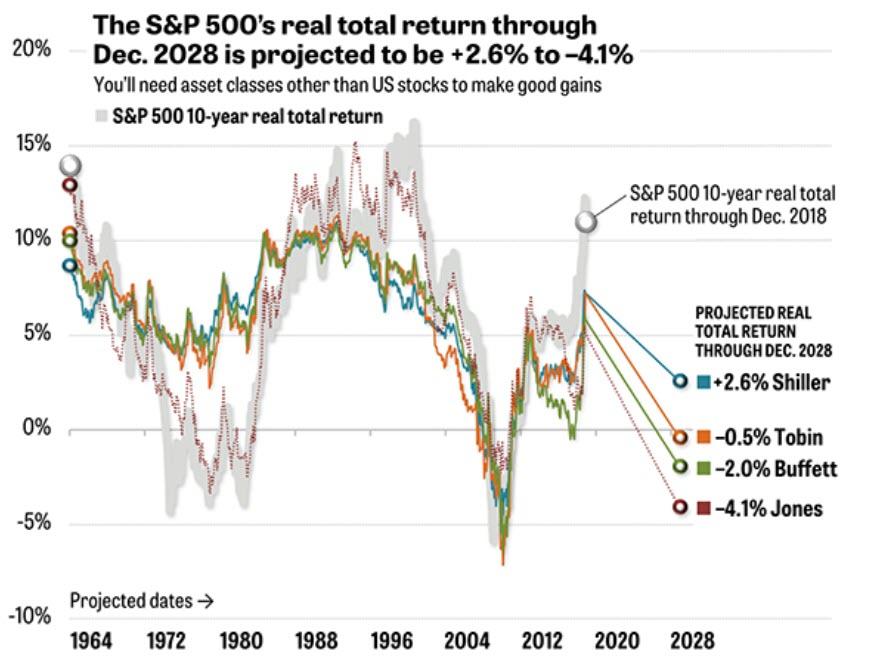“How Low Will The S&P Go? Buffett & Shiller Know…”
Im Einkauf liegt der Gewinn. Daran habe ich immer wieder bei bto erinnert, zuletzt bei meinem Blick auf die Börse in London. Dabei eignen sich die Bewertungen nicht, um Einbrüche an den Börsen vorherzusagen, sie eignen sich aber, um künftige Erträge zu prognostizieren.
Wie es für die USA zurzeit aussieht, fasst ein Analyst hier zusammen, zitiert via Zero Hedge, da das Original nicht verfügbar:
- “Financial experts like Warren Buffett and Robert Shiller are creators of long-term projection methods with data that goes back more than half a century. It’s well known that Buffett is one of the world’s richest people, and that Shiller won a 2013 Nobel Prize in Economics partly for developing his forecasting formula. Whether or not these seers actually have crystal balls, things have worked out pretty well for them.” – bto: Und deshalb werden vier Methoden auf die US-Börse angewandt.
“The graph above doesn’t show the S&P 500’s price levels. Instead, it reveals how well the projection methods estimated the market’s 10-year rate of return in the past. The round markers on the right are the forecasts for the 10 years that lie ahead of us. All of the numbers for the S&P 500 include dividends but exclude the consumer-price index’s inflationary effect on stock prices.” – bto: Es sind also reale Erträge inklusive Dividenden.
- “Shiller’s P/E10 predicts a 2.6% annualized real total return. Take today’s S&P 500 price and divide it by its companies’ average inflation-adjusted earnings over the past 10 years. This gives you a ratio that suggests whether the market is overpriced or underpriced. If you could buy one ‘share’ of the S&P 500 index, your account would be worth around $2,700. After 10 years of 2.6% gains, you’d have $3,490.” – bto: Die Annahme dahinter ist, dass das Shiller-KGV zum langfristigen Durchschnitt konvergiert. Das ist nicht implausibel.
- “Buffett’s MV/GDP says minus 2.0%. Divide the S&P 500’s market value by the U.S. gross domestic product. Buffett wasn’t the first person to suggest this metric, but he’s said on the record that it’s ‘probably the best single measure of where valuations stand.’ If the index fell 2.0% annualized, your $2,700 would turn into $2,206. Not so great.” – bto: Die Börse ist also relativ zum BIP teuer. Fällt die Quote auf den langfristigen Durchschnitt, ergibt sich sogar ein absoluter Verlust.
- “Tobin’s ‘q’ ratio indicates minus 0.5%. This metric divides the market value of all U.S. equities (not just the ones in the S&P 500) by the cost to replace all of the companies’ assets. It’s based on academic papers by economists James Tobin, a 1981 Nobel laureate, and William Brainard. This formula predicts that your S&P 500 account will drift slightly lower in real terms, not quite keeping up with inflation.” – bto: wobei ich hier noch skeptischer wäre. Die Bilanzen der Unternehmen waren früher seriöser. Heute wird zu viel gefudged.
- “Jones’s Composite says minus 4.1%. Jones uses Buffett’s formula but adjusts for demographic changes. For example, as America’s population ages, this reduces economic demand. The resulting Demographically and Market-Adjusted (DAMA) Composite has predicted the S&P 500’s 10-year returns more closely than any of the other formulas since 1964. Let’s hope he’s wrong. A 4.1% annualized loss would drive your $2,700 account down to $1,776 after 10 years. That would be a 34% decline, almost as bad as the ‘lost decade’ of 2000 through 2009.” – bto: Auch das klingt undenkbar, was aber nicht bedeutet, dass es unrealistisch ist.
“(…) these formulas (…) aren’t guarantees and can’t be used to time the market. (…) ‘The market’s return over the past 10 years,’ Jones explains, ‘has outperformed all major forecasts from 10 years prior by more than any other 10-year period.’ He attributes this to the unprecedented stimulation that the Federal Reserve pumped into the economy (and is now removing — watch out below). Markets tend to revert to their average performance over time, which is not nearly as much fun as it sounds.” – bto: Das leuchtet zu 100 Prozent ein. Es kann keine dauerhafte Abweichung von fundamental gerechtfertigten Werten geben, selbst, wenn die Notenbanken es noch so sehr versuchen. Klar, sie können das Geld völlig entwerten. Besser Sach- als Finanzwert. Dennoch bleibt real nur ein besserer Vermögenserhalt. Relativ.
Das spricht für Diversifikation: “Those diversifying assets include real-estate investment trusts, commodities, precious metals, and non-US stocks and bonds.” – bto: Das gilt aus US-Sicht. Deutsche Assets sollten das aber nicht unbedingt sein, sind wir doch die großen Verlierer des Euro-Endgames.
→ zerohedge.com: “How Low Will The S&P Go? Buffett & Shiller Know…”, 29. Januar 2019








